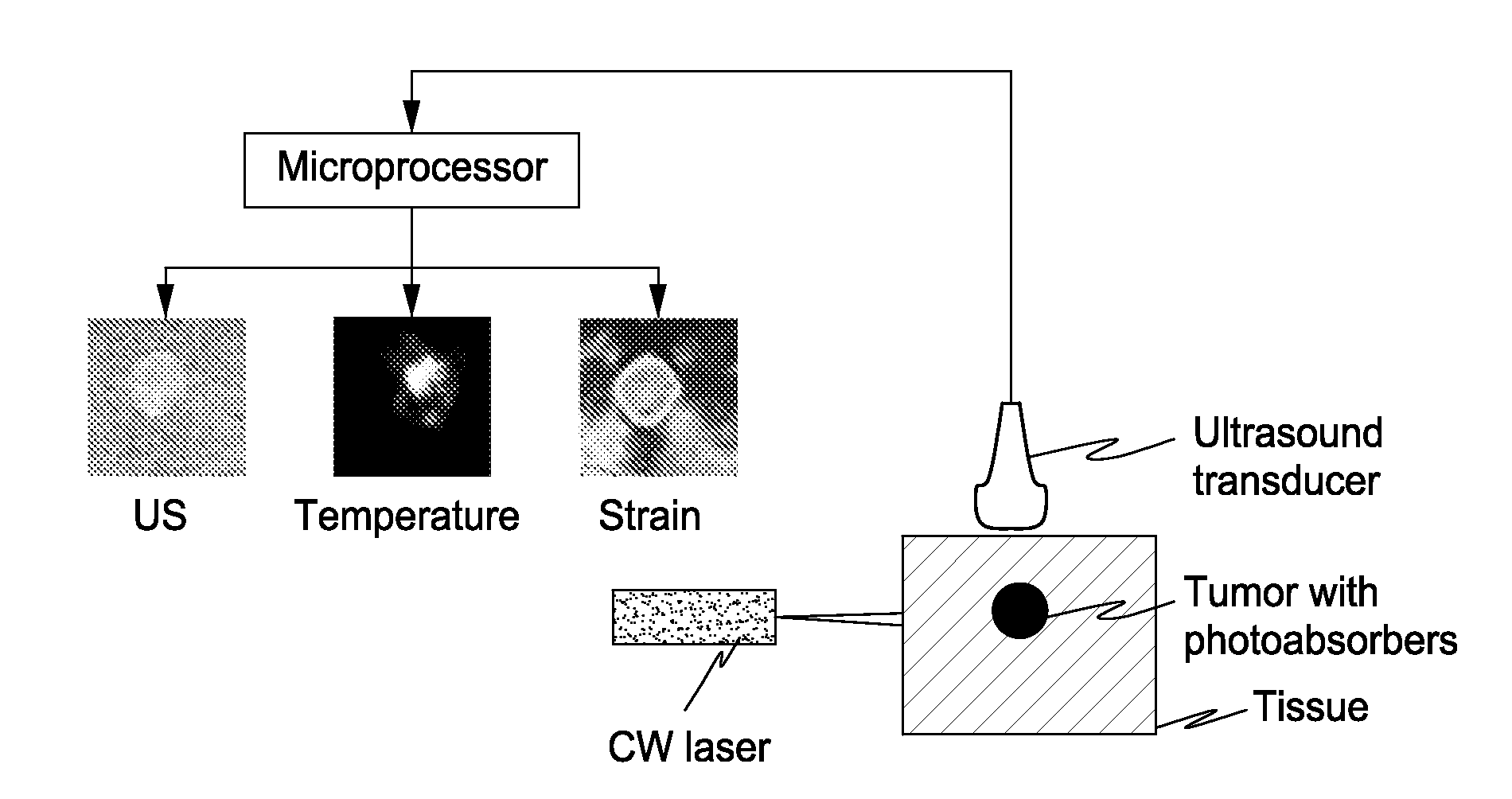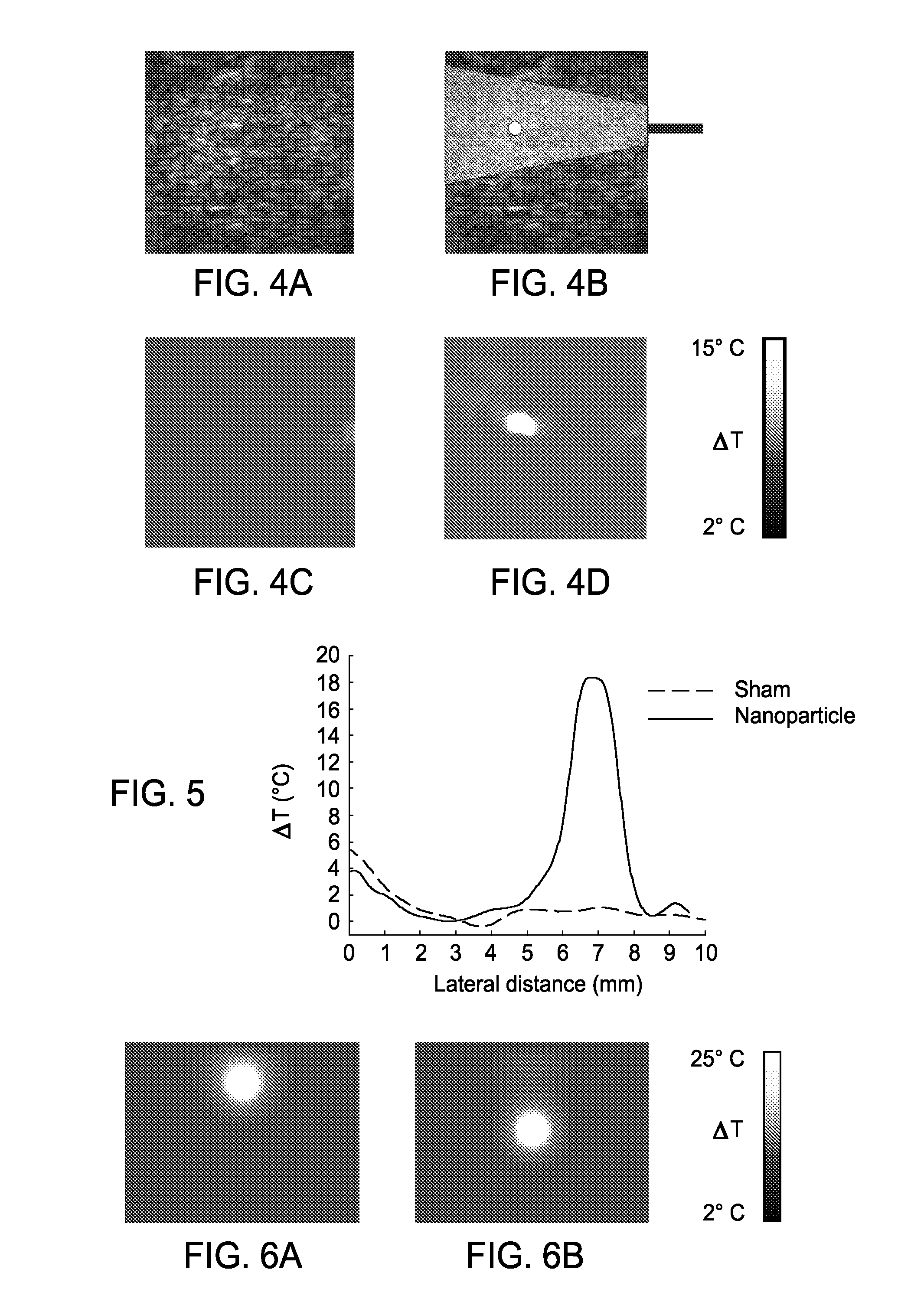Real-Time Ultrasound Monitoring of Heat-Induced Tissue Interactions
a real-time ultrasound and tissue technology, applied in the field of thermal therapy, can solve the problems of inability to provide an accurate temperature read-out, method that cannot work, and limited technique to skin applications,
- Summary
- Abstract
- Description
- Claims
- Application Information
AI Technical Summary
Benefits of technology
Problems solved by technology
Method used
Image
Examples
example 1
Ultrasound-Based Thermal and Elasticity Imaging to Assist Photothermal Cancer Therapy
[0042]Photothermal therapy is a targeted, non-invasive thermal treatment of cancer. Up to 40° C. temperature increase is obtained in a small volume of malignant cells by using appropriate photoabsorbers and irradiating the tissue with a continuous wave laser. However, in order to ensure successful outcome of photothermal therapy, the tumor needs to be imaged before therapy, the temperature needs to be monitored during therapy and, finally, the tumor needs to be evaluated for necrosis during and after therapy. We investigated the feasibility of ultrasound imaging to track temperature changes during photothermal therapy and elasticity imaging to monitor tumor necrosis after treatment. The image-guided therapy was demonstrated on tissue mimicking phantoms and ex-vivo animal tissue with gold nanoparticles as photoabsorbers. Ultrasound-based thermal imaging effectively generates temperature scans during ...
example 2
Ultrasound Imaging to Monitor Photothermal Therapy Augmented by Plasmonic Nanoparticles
[0065]Metal nanoparticles are often used during photothermal therapy to efficiently convert light energy to thermal energy causing selective cancer destruction. This study investigates the feasibility of ultrasound imaging to monitor temperature changes during photothermal treatment. A continuous wave laser was used to perform photothermal therapy on tissue mimicking phantoms with embedded gold nanoparticles acting as photoabsorbers. Photothermal therapy studies were also carried out on ex-vivo tissue specimen with gold nanoparticles injected at a specific site. Prior to therapy, the structural features of the phantoms and tissue were assessed by ultrasound imaging. Thermal mapping, performed by measuring thermally induced motion of ultrasound signals, showed that temperature elevation obtained during therapy was localized to the region of embedded or injected nanoparticles. The results of our stu...
example 3
Ultrasound Guidance and Monitoring of Laser-Based Fat Removal
[0088]The present example used ultrasound imaging to guide laser removal of subcutaneous fat. Ultrasound imaging was used to identify the tissue composition and to monitor the temperature increase in response to laser irradiation. Laser heating was performed on ex-vivo porcine subcutaneous fat through the overlying skin using a continuous wave laser operating at 1210 nm optical wavelength. Ultrasound images were recorded using a 10 MHz linear array-based ultrasound imaging system. Ultrasound imaging was utilized to differentiate between water-based and lipid-based regions within the porcine tissue and to identify the dermis-fat junction. Temperature maps during the laser exposure in the skin and fatty tissue layers were computed. This example demonstrates the use of ultrasound imaging to guide laser fat removal.
[0089]Liposuction, also known as lipoplasty, is an invasive procedure for subcutaneous fat removal and body resha...
PUM
 Login to View More
Login to View More Abstract
Description
Claims
Application Information
 Login to View More
Login to View More - R&D
- Intellectual Property
- Life Sciences
- Materials
- Tech Scout
- Unparalleled Data Quality
- Higher Quality Content
- 60% Fewer Hallucinations
Browse by: Latest US Patents, China's latest patents, Technical Efficacy Thesaurus, Application Domain, Technology Topic, Popular Technical Reports.
© 2025 PatSnap. All rights reserved.Legal|Privacy policy|Modern Slavery Act Transparency Statement|Sitemap|About US| Contact US: help@patsnap.com



